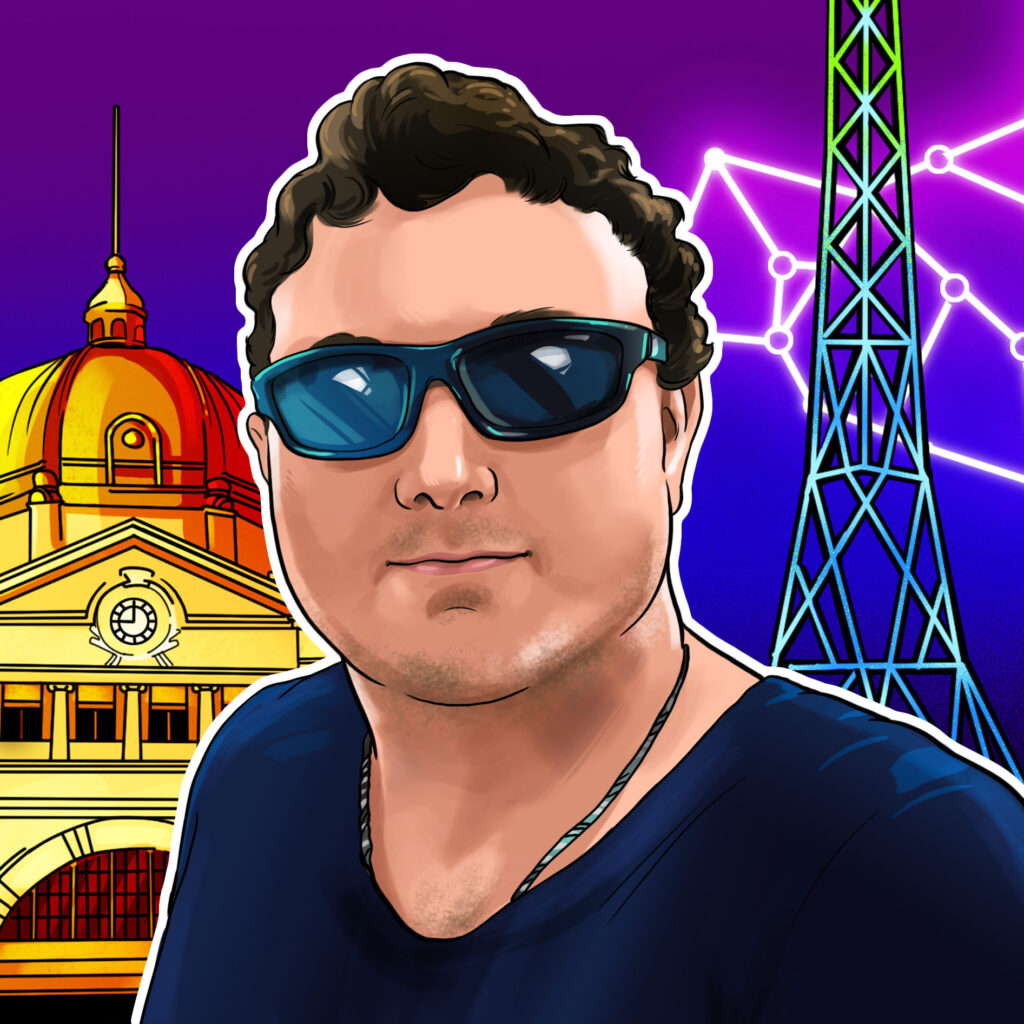Charles Hoskinson is arguably the best and worst thing about Cardano. Without him, of course, the chain would not exist — he’s driven its development over the past decade and claims he invested $450 million of his own funds into bootstrapping the network.
But he’s also a magnet for bad publicity who makes everything about him and constantly picks pointless fights. This week, for example, he’s threatening to sue Wyoming for not using Cardano for its stablecoin. He frequently overshadows the network’s many technical achievements in terms of decentralization, governance and its new privacy-focused sidechain, Midnight.
Despite just having turned 37, he looks like a semi-retired professor with his retreating hairline, greying beard and signature colorful shirts — during our interview at Token2049 he was wearing a kitten. Being born middle-aged may have helped spark his keen interest in researching experimental stem cell longevity therapies, which he plans to trial on himself to turn the clock back 10 years.
With a fortune of around $1.2 billion (according to him), Hoskinson has enough money to do whatever he likes — whether it’s hunting alien artifacts, gene editing glow-in-the-dark plants, or trying to convince world leaders like Argentina’s Javier Milei and the Trump transition team of the benefits of crypto and/or running the world on Cardano.


Hoskinson and controversy
Hoskinson’s amount of wealth is often called “fuck you money,” and he appears to embody the idiom, frequently saying controversial things and insulting other projects and people in his characteristically blunt way.
When we were introduced, Magazine joked that we were “hoping you’ll say something horribly controversial, and then we can get a great news story out of it.”
And that’s precisely what happened after Hoskinson explained at length why Ethereum is run like a dictatorship. After Cointelegraph published a news story to that effect, he very publicly complained about being accurately quoted. Not being misquoted, or quoted out of context — he was just upset that a story was published based on something he said.


During a livestream with David Gokhshtein, the Cardano founder complained about how unfair it was to only quote some of the interesting things he said in a 500-word news story, despite the fact the interview transcript is 11,000 words long.
“Get fucking bent, Cointelegraph. Be fucking better. You’re trash for that. So, that’s it, no more interviews with them.”
How to win friends and influence people
Some might think it’s more in Cardano’s interests to try to befriend the media instead of attacking it, in the hopes of onboarding some new users.
While the network’s daily users have recently increased from around 30,000 to almost 100,000 on some days after its token price tripled, it only just crossed 100 million lifetime transactions, according to the Cardano Foundation. To put that in perspective, the Ethereum ecosystem sometimes sees 20 million transactions in a single day.


But Hoskinson’s instinct seems to be to lean into the drama rather than cool it down. For example, a few weeks after our interview in Singapore, he inadvertently posted about a memecoin that went on to rug some users, leading a small X account to tell its 12,000 followers that that sort of behavior made Hoskinson the “cancer of Cardano.”
Instead of ignoring the insult, Hoskinson put up a poll for his almost 1 million followers asking if he really was a “cancer for Cardano.” He then got extremely sulky after 51.6% of the 50,501 respondents agreed that yes, he was.


Stung from this self-inflicted wound, he sniffly announced he was going offline for a time, saying he was fed up with being “subjected to regular abuse and extraordinarily hurtful statements on a daily basis.”
While Hoskinson’s huge army of supporters chimed in, not everyone was sympathetic. One of the top early replies to the poll said: “The fact you are making such a poll is the issue Charles. This is like watching Elon implode on the internet.”
Another wrote: “You’re the founder of this chain and a public figure. Maybe you don’t need to address every criticism like we’re in high school?”
Read also
Let’s talk about Voltaire era governance
What Hoskinson really wants to talk about is the Voltaire era governance upgrade for Cardano, which puts power back in the hands of the community through a representative governance system.
But he draws focus away from the upgrade by talking about it in a massively self-congratulatory manner while throwing shade at other projects.
“What Cardano has done is one of the greatest technical achievements in human history,” he wrote in early September after the Chang update went live. “This dwarfs Bitcoin. It’s unique, and books will be written about what has happened.”
He also predicted Cardano would overtake Ethereum within a decade and Bitcoin within two, with the frankly huge claim that the majority of the world’s governments would eventually be running on Cardano infrastructure. He also stated:
“The biggest threat to Bitcoin’s dominance has and always will be Cardano.”
Elsewhere, he’s said of the original and best-loved cryptocurrency: “I don’t see how [Bitcoin] survives. It’s a religion, not an ecosystem.” He compared it to Microsoft Windows, which “no one cares about anymore” due to the adoption of mobile devices.
“It just becomes another asset, the hashrate falls, and it kind of dies a slow heat death.”


Having slammed Bitcoin on numerous occasions, he then switched gears recently to talk up its massive importance instead. He said he “almost cried” when he saw a ZK-proof transaction enabling Bitcoin to be used trustlessly via a bridge on Cardano.
“That’s huge, absolutely huge, gargantuan for Cardano. It’s probably the biggest news item we’ve ever had.”
What is the Voltaire era governance upgrade?
Having spent 800 words of this story talking about Hoskinson rather than Voltaire era governance, let’s delve into what seems like a pretty impressive upgrade. Since it went live a couple of months ago, Weiss Crypto has upgraded ADA to an A-, joining only BTC and ETH in the top tier of its ratings.


Like many things on Cardano, governance has been carefully considered and researched within an inch of its life. It has essentially turned the network into the world’s biggest DAO, taking control from the founding organizations — IOHK, Emurgo and the Cardano Foundation — and handing it over to the community.
ADA holders get to vote on delegated representatives (think congresspeople), who vote on their behalf on things like upgrades and treasury management. Stake pool operators also get a say, and there’s a constitutional committee to limit code changes during the first three months.
The forthcoming constitution, which is currently in draft form, will set hard limits on the changes allowed — such as changes to the supply or anything that might undermine the democratic nature of voting.
A total of 64 workshops in 51 countries have been held to nut out the details and elect 128 representatives to vote on the final version at the constitutional convention in Buenos Aires in early December.
“What are the fundamental rights incumbent within the system? That if you hold ADA, you know are invariance, like the deflationary monetary policy, or the burning of the treasury, or the existence of a treasury,” he explained in Singapore. “And what are things that should be, on an annual basis, open to debate?”
Hoskinson is an advocate for a deflationary monetary policy and for Cardano’s treasury to never be burned off simply to prop up token prices, as some in the community immediately suggested.
“But obviously, I can’t unilaterally decide that. It’s an onchain governance system,” he said.


Cardano governance vs. Ethereum governance
On paper, at least, Cardano’s model sounds more democratic than Ethereum’s, which is a largely informal system of Ethereum Improvement Proposals that are discussed by the community before a small group of core devs gives them the nod.
Ethereum creator Vitalik Buterin has expressed unease with onchain governance, arguing that it can concentrate power among large tokenholders, most votes see quite low participation, and many decisions are too complicated for a simple yes/no answer.
So, Magazine asked about the strengths and weaknesses of Cardano’s approach against Ethereum’s.
In response, Hoskinson explained that blockchains have a few choices for governance models. They can elect to keep the protocol forever simple, like Bitcoin, which means “there’s no debate needed.”
“It doesn’t do a lot, and that’s by design. It’s a feature, not a bug, for that ecosystem. Or you have to eventually pick a king and just say you’re in charge and go do this stuff. Either it’s a foundation or a benevolent leader. And most open-source projects do that, like Linus with Linux.”
“So, if you build onchain governance, you’re rejecting both sides of that, and you’re saying, instead, you’re going to have, kind of, three properties of good governance.”


He explained that the first property is democratic consent, by electing delegates who are representative of the diverse interests in the ecosystem.
The second is to have institutions like Cardano’s member-based organization Intersect that can “translate complexity into simplicity” so that “by the time it gets to that onchain government, you’ve already pre-chewed an enormous amount of the labor, and you’ve kind of presented a vision of where things go.”
The third part is having a defined constitution to keep governance on track and set the ground rules around scalability, money issuance, minority rights, uncensorable transactions, etc.
“If you have those three things, then you have a fair shot of avoiding the anarchy of Bitcoin or the dictatorship of Ethereum, and you actually have something that can move forward with one voice, but it’s still decentralized at the end of the day, because it represents everybody.”
Read also
Wait, what?
Hold on… Did Hoskinson really just call Ethereum a dictatorship? Magazine gave him the chance to walk the comment back in case it was just a throwaway line:
“Can I just stop you there and get you to clarify? You called Ethereum a dictatorship. But they’re not really a dictatorship…”
But he didn’t walk it back — he doubled down.
“The entire vision comes from a single person. ‘Oh yes, Vitalik’s not in charge.’ Well, everybody looks to him for the roadmap. Everybody looks to him for inspiration, and also he’s the only person who has enough power to rally people,” he said.
“If you remove him from the equation, right now, what’s the next hard fork going to look like, and how quickly can they actually get there? Where does this idea of embracing layer 2s come from, or rollups come from, or these other things? Was it some random Ethereum engineer or something like that? Or was it Vitalik Buterin writing a blog post about it, talking about it, advocating for it.”
You can sort of understand where Hoskinson is coming from, given Ethereum was initially supposed to have been a collaborative project between Buterin and seven other co-founders, including Joe Lubin of Consensys and Hoskinson himself.
But when push came to shove, during a disagreement over making Ethereum a for-profit company in 2014, Buterin emerged as the first among equals and made the decision by himself. He not only made Ethereum a nonprofit, but he fired Hoskinson as CEO at the same time.


Ironically, of course, if the description of “dictator” applies to Buterin, it would also apply to Hoskinson’s role in leading Cardano since 2015. He’s been every bit as central to Cardano as Buterin is to Ethereum.
“Not anymore!” he said, pointing out that 168 scientists have written 223 papers to help research Cardano’s technology.
“And all those papers are written by people that are faceless. If you add [one], you take one out, doesn’t change the calculus of it. It’s a decentralized brain,” he said.
“So, I alive, Charles alive/dead, doesn’t matter. There’s still going to be innovation on a daily basis.”
Removing the single point of failure
Hoskinson conceded that he’ll have an ongoing role as a figurehead, but without material power.
“It’s hard for founders to fire themselves. Even Satoshi had a little bit of a challenge in the beginning days to kind of get out of Bitcoin and hand over the right leadership structure.”
So, are you trying to fire yourself?
“Yes, that’s the goal. That’s the goal. Any founder of an open-source decentralized [ecosystem’s goal] should be that you can’t have a single point of failure.”


And so, as the community progressively takes control of the project, it’ll no longer matter as much if Hoskinson causes controversy.
He’ll just be another community member, with no more say on governance than any other holder of hundreds of millions of dollars worth of ADA. But given his huge influence to date, will he also emerge as first among equals?
Subscribe
The most engaging reads in blockchain. Delivered once a
week.




Andrew Fenton
Based in Melbourne, Andrew Fenton is a journalist and editor covering cryptocurrency and blockchain. He has worked as a national entertainment writer for News Corp Australia, on SA Weekend as a film journalist, and at The Melbourne Weekly.
Read also
Telegram CEO cannot leave France, OpenSea receives Wells notice, and more: Hodler’s Digest, Aug. 25 – 31
Telegram CEO Pavel Durov has been placed under judicial supervision after a court appearance, OpenSea receives Well Notice: Hodler’s Digest
VanEck files for Solana ETF, Ether supply inflates, and more: Hodler’s Digest, June 23-29
VanEck seeks approval for Solana ETF, ETH supply rises 73 days in a row, and Satoshi-era wallet moves Bitcoin.




Leave a Reply